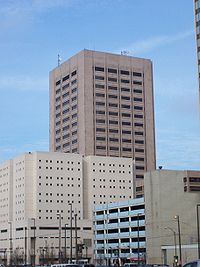- Justice Center Complex (Cleveland, Ohio)
-
The Justice Center Complex is a building complex located in downtown Cleveland, Ohio that opened in 1976. It consists of the Cleveland Police Headquarters Building, the Cuyahoga County and Cleveland Municipal Courts Tower, and the Correction Center. It occupies a city block bounded by Lakeside Avenue, Ontario Street, West 3rd Street, and St. Clair Avenue. The Lakeside Avenue entrance faces the Cuyahoga County Court House, erected in 1912.
 Isamu Noguchi's Portal
Isamu Noguchi's Portal
When the Justice Center was proposed in 1969, then-Mayor Carl B. Stokes did not want to be part of the Justice Center project. At the time, the Cleveland Police were at an older headquarters on East 22nd Street. In 1971, voters elected Mayor Ralph Perk, who accepted the police department recommendation to move to the proposed Justice Center. The original cost for the Justice Center was set at $60 million, but infighting between Cuyahoga County and City of Cleveland officials escalated the cost from $60 million dollars to $128 million dollars. On October 20, 1972 ground was broken for the Justice Center.
The Courts Tower was designed by Prindle, Patrick and Partners. The Brutalist 26-story structure stands 420 ft (128 m) high and contains 44 court rooms and 9 hearing rooms, which are divided between Cleveland Municipal and Cuyahoga County Common Pleas courts.[1] Located south of the Courts Tower is Cleveland's Police Headquarters Building. The Police Headquarters, designed by Richard L. Bowen and Associates serves the city's police department. Located in front of the building is the Isamu Noguchi sculpture, Portal, one of the most recognizable symbols of the Justice Center. When Portal was built, Cleveland's art critics said it looked like one leftover caisson sticking up, while another critic called it "Justice going down the drain." It was donated by the Gund Foundation in 1977 and it one of Isamu Noguchi's famous sculptures. West of the Courts Tower is the Correction Center. The Correction Center is composed of Jail I and Jail II. Jail I was built in 1976, when the rest of the construction of the complex was completed. It allows 777 cells, arranged in pods of 23 to be flooded with daylight. In 1995, a counterpart, the Robert P. Madison-designed Jail II, was finished, for a total capacity of 1800 cells.
The bases of both the Police and Correction facilities are deeply recessed with a regular spacing of bays and perimeter columns with additional horizontal elements which act to cohere the grouping. Bronze tinted glass enhances the play of shadow upon the surface of the structures. Ground level changes are resolved through the use of a dynamic multilevel light court within. Circulation between the buildings occurs through the block by way of this light court which opens with suspended glass walls to the north, south, and east. This directly links the heart of the Justice Center with Ontario, Lakeside, and St. Clair Avenue.
Contents
See also
References
- ^ Norman, Michael (June 21, 2007). "Cleveland: A Brutalist Tour". The Plain Dealer (Cleveland, Ohio). http://blog.cleveland.com/pdextra/2007/06/cleveland_a_brutalist_tour.html. Retrieved July 7, 2010.
Further reading
- Toman, James. Cleveland's Changing Skyline, 1984. Cleveland Landmarks Press. ISBN 0-936760-03-6.
External links
Current county courthouses of Ohio Adams • Allen • Ashland • Ashtabula • Athens • Auglaize • Belmont • Brown • Butler • Carroll • Champaign • Clark • Clermont • Clinton • Columbiana • Coshocton • Crawford • Cuyahoga (Courthouse, Justice Center) • Darke • Defiance • Delaware • Erie • Fairfield • Fayette • Franklin • Fulton • Gallia • Geauga • Greene • Guernsey • Hamilton • Hancock • Hardin • Harrison • Henry • Highland • Hocking • Holmes • Huron • Jackson • Jefferson • Knox • Lake • Lawrence • Licking • Logan • Lorain • Lucas • Madison • Mahoning • Marion • Medina • Meigs • Mercer • Miami • Monroe • Montgomery • Morgan • Morrow • Muskingum • Noble • Ottawa • Paulding • Perry • Pickaway • Pike • Portage • Preble • Putnam • Richland • Ross • Sandusky • Scioto • Seneca • Shelby • Stark • Summit • Trumbull • Tuscarawas • Union • Van Wert • Vinton • Warren • Washington • Wayne • Williams • Wood • WyandotCoordinates: 41°30′5.31″N 81°41′48.96″W / 41.501475°N 81.6969333°W
Categories:- Buildings and structures completed in 1976
- Brutalist architecture in the United States
- Cleveland Division of Police
- Police headquarters
- County government buildings in Ohio
- County courthouses in Ohio
- Prisons in Ohio
- Skyscrapers in Cleveland, Ohio
- Skyscrapers between 100 and 149 meters
Wikimedia Foundation. 2010.

